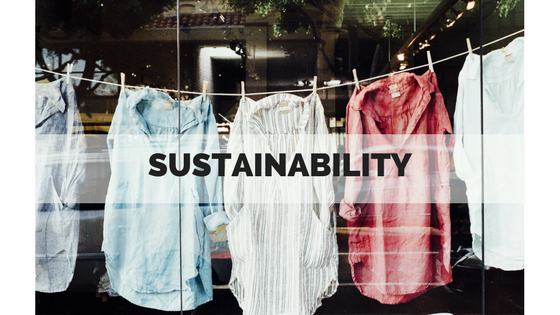
The fashion industry is named the 2nd dirtiest industry accountable for an environmental issue to our Earth: Pollution.
When we think of pollution, we envision coal power plants, strip-mined mountains and raw sewage piped into our water sources. Who would have ever thought the t-shirts on our backs contributes as a harmful impact to earth? The overall impact the fashion industry has on our planet is irreversible.
Maybe we can start by understanding the life cycle of a T shirt. The product life cycle shows the stages a product goes through over time in relation to how it makes its economical and social contribution to the society.
There are 5 major stages in the life cycle of any piece of garment: material, production, shipping, use and disposal. According to a UK study published in 2009 the material, production and transport phases of one t-shirt weighing approximately 6 ounces produced in India uses: 700 gallons of water, .22 pounds of fertilizers, .01 pounds of pesticides and 1.2 pounds of fossil fuels.
The material stage it alone involves farming, irrigating, fertilizing, harvesting and ginning. China, India and the US holds the title of the world’s largest producers of cotton and accounts for nearly 75% of its production. While cotton is a natural fiber and not as harmful as man-made polyester, the production phase intermediary adds on as wastage and pollution. Farming also means that there is a huge amount of water and pesticides usage.
Following the harvest of the material, spinning, knitting, wet process, bleaching, dyeing, confection, cutting and sewing is all part of the production stage- the process consumes an extremely enormous amount of water and energy. Bleaches and commercial dyes used during the process also harmful pollutants with presence of sulphur, naphthol, vat dyes, nitrates, acetic acid, soaps, enzymes chromium compounds and heavy metals like copper, arsenic, lead, cadmium, mercury, nickel, and cobalt and certain auxiliary chemicals all collectively make the textile effluent highly toxic.
After the production of the T-shirt, it enters into the transportation stage into the distribution channels and can travel by air, land and sea, spilling pollutants into the ecosystem. Studies show that clothing distribution accounts for 10% of the global carbon emission footprint.
Once the garment enters into the retail stores and purchased, it enters into the used stage. Taking into consideration, the water and electricity combined together used during its life cycle, it too becomes a form of wastage and additional source of pollutant to our water source.
Entering its final stage of retirement, the garment goes into the disposal stage. According to the U.S. EPA in 2014, over 16 million tons of textile waste was generated,. Out of the 16 million, 2.62 million tons were recycled, 3.14 million tons were combusted for energy recovery, and 10.46 million tons were sent to the landfill.
The latest fashion trends fascinates many and we all need new clothes once in a while. But maybe reusing and recycling or even buying from sustainable sources can help to save the earth. Replacing the worn out rag with a piece of old clothing, instead of throwing your old clothes which might probably end up in the landfill, donating your old but usable clothes to textile recycling organisations.
Or even shop responsibly and support companies that does sustainable clothing lines that has either environmental or social ethical principles behind to their brands:
EVERLANE
Besides a leader in sustainable apparel, Everlane is also radically transparent about their pricing. Check out their latest #LoveYourUnderwear campaign highlighting the use of real cotton in the underwear line for both men and women.
Shop them here: https://goo.gl/25C3fe
REFORMATION

With stores located in California, New York and Texas, the label clothing line repurposed vintage clothing, use rescued deadstock fabrics and renewable plant material.
Shop them here: https://goo.gl/uB13au
PATAGONIA

An American clothing company that sells outdoor clothing since 1973, Patagonia uses recycled polyester in many of their clothes and only organic, rather than pesticide-intensive cotton used.
Shop them here: https://goo.gl/yJRHwJ
ADAY

Based in New York, the label carries a line of simplicity designed outfits where many of the label’s clothes are made from recycled materials.
Shop them here: https://goo.gl/gERLvi
Basics for Basics

Located in Hong Kong, the label clothing line is made from organic fabrics, produced in fair trade factories in India.
Shop them here: https://goo.gl/V39JHj
Transcend Wear

Need a new set of bikini for your upcoming summer break? Transcend’s swimwear bikini’s are made from regenerated fishing nets, carpet and other nylon waste. How cool is that!
Shop them here: https://goo.gl/xBySX6
The Root Collective

If you’re a shoe-aholic like me, try Root Collective, with every purchase you make you create jobs for people who need them.
Shop them here: https://goo.gl/qPMqjr
So shop less or go green the next time when you shop. Green is the new black!
Reference:
http://edition.cnn.com/specials/living/tshirt-lifecycle/2012/index.html
https://ed.ted.com/lessons/the-life-cycle-of-a-t-shirt-angel-chang
https://www.thebalance.com/textile-recycling-facts-and-figures-2878122



